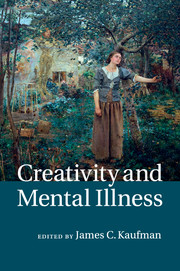Book contents
- Frontmatter
- Dedication
- Contents
- List of figures
- List of tables
- List of contributors
- Preface
- Acknowledgments
- Part I Creativity and mental illness: the state of the field
- Part II Cognitive and neuroscientific perspectives on creativity and mental illness
- Part III Creativity and the spectrum of mental illness
- Part IV Creativity and mental illness: possible commonalities
- 12 The shared vulnerability model of creativity and psychopathology
- 13 On the fragility of the artist: art’s precarious triad
- 14 Creativity as “compensatory advantage”: bipolar and schizophrenic liability, the inverted-U hypothesis, and practical implications
- Part V Creativity and mental health
- Part VI Creativity and mental illness: what now?
- Index
- References
12 - The shared vulnerability model of creativity and psychopathology
from Part IV - Creativity and mental illness: possible commonalities
Published online by Cambridge University Press: 05 August 2014
- Frontmatter
- Dedication
- Contents
- List of figures
- List of tables
- List of contributors
- Preface
- Acknowledgments
- Part I Creativity and mental illness: the state of the field
- Part II Cognitive and neuroscientific perspectives on creativity and mental illness
- Part III Creativity and the spectrum of mental illness
- Part IV Creativity and mental illness: possible commonalities
- 12 The shared vulnerability model of creativity and psychopathology
- 13 On the fragility of the artist: art’s precarious triad
- 14 Creativity as “compensatory advantage”: bipolar and schizophrenic liability, the inverted-U hypothesis, and practical implications
- Part V Creativity and mental health
- Part VI Creativity and mental illness: what now?
- Index
- References
Summary
Creative individuals frequently describe the creative process as irrational. Even those luminaries who are in the most rational and logic-driven of fields, such as physics and mathematics, attest to the irrational and illogical nature of creative accomplishments. The empiricist Karl Popper, for example, wrote that “every discovery contains ‘an irrational element’ or ‘a creative intuition’” (Popper, 1959/2005, p. 8). The mathematician Poincaré suggested that “logic has very little to do with discovery or invention” (cited in Beveridge, 1957, p. 85). Regarding scientific creativity, Einstein wrote that “there is no logical way to the discovery of these elemental laws. There is only the way of intuition” (Einstein, 1952, p. 10).
Given that there is often a perceived illogical or irrational component to creative work (an intuitive leap, so to speak), it is reasonable to suggest that cognitive states that allow access to intuitive or irrational thought processes might promote creative ideation. Psychopathological brain states, which are often characterized by irrational thought processes, may act as doorways into the chaotic and irrational aspects of thought that can inspire intuitive leaps of imagination and creative ideas (see Jamison, 1993; Norlander, 1999; Prentky, 1989, 2000–2001).
- Type
- Chapter
- Information
- Creativity and Mental Illness , pp. 253 - 280Publisher: Cambridge University PressPrint publication year: 2014
References
- 10
- Cited by



